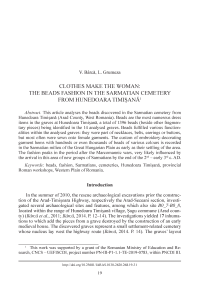Clothes make the woman: the beads fashion in the Sarmatian cemetery from Hunedoara Timisana
Автор: Barca V., Grumeza L.
Журнал: Краткие сообщения Института археологии @ksia-iaran
Статья в выпуске: 268, 2022 года.
Бесплатный доступ
This article analyses the beads discovered in the Sarmatian cemetery from Hunedoara Timisana (Arad County, West Romania). Beads are the most numerous dress items in the graves at Hunedoara Timisana, a total of 1396 beads (beside other fragmentary pieces) being identified in the 14 analysed graves. Beads fulfilled various functionalities within the analysed graves: they were part of necklaces, belts, earrings or buttons, but most often were sewn onto female garments. The custom of embroidery-decorating garment hems with hundreds or even thousands of beads of various colours is recorded in the Sarmatian milieu of the Great Hungarian Plain as early as their settling of the area. The fashion peaks in the period after the Marcomannic wars, very likely influenced by the arrival in this area of new groups of Sarmatians by the end of the 2nd - early 3rd c. AD.
Beads, fashion, sarmatians, cemeteries, hunedoara timisana, provincial roman workshops, western plain of romania
Короткий адрес: https://sciup.org/143180123
IDR: 143180123 | DOI: 10.25681/IARAS.0130-2620.268.19-31
Список литературы Clothes make the woman: the beads fashion in the Sarmatian cemetery from Hunedoara Timisana
- Барачки Ст., 1961. Сарматски налази из Вршца // Рад војвођанских музеја. № 10. C. 117–143.
- Antonaras A. Ch., 2017. Glassware and Glassworking in Thessaloniki 1st Century BC – 6th Century AD. Oxford: Archaeopress. 383 p., tab. 35–54. (Archaeopress Roman Archaeology; 27.)
- Bârcă V., 2014. Sarmatian Vestiges Discovered South of the Lower Mures River. The Graves from Hunedoara Timișană and Arad. Cluj-Napoca: Mega Publishing House. 285 p.
- Bârcă V., 2016. Disc brooches of box/capsule type (Dosenfibel/Kapselfibel) in the Sarmatian environment of the Great Hungarian Plain. A few notes on their dating and origin // Orbis Romanus and Barbaricum. The Barbarians around the Province of Dacia and Their Relations with the Roman Empire / Ed. V. Bârcă. Cluj-Napoca: Mega Publishing House. P. 251–282.
- Bârcă V., 2017. Notes on the metal pyxides recently discovered in the Sarmatian environment south the Lower Mureș River // Plural. History-Culture-Society. Vol. 5. No. 2. P. 101–123.
- Bârcă V., Ursuţiu A., Cociş S. I., Stăncescu R. E., Ţuţuianu C. D., Irimuş L., Cociş Al., Sălcudean C., Bondric A., Brehuescu Al., 2011. Hunedoara Timişană, com. Şagu, jud. Arad, Punct: Autostrada Arad-Timişoara, tronson Arad-Seceani, km 23+170 – 23+690 (siturile B0_7-B0_8) // Cronica cercetărilor arheologice din România. Campania 2010. Sibiu: Muzeul Naţional Brukenthal, 2011. P. 187–192.
- Benea D., 1996. Dacia sud-vestică în secolele III–IV. Timişoara: Editura de Vest. 306 p.
- Benea D., 2004. Die Romischen Perlenwerkstaetten aus Tibiscum = Atelierele romane de mărgele de la Tibiscum. Timișoara: Excelsior Art. 287 p.
- Bozsik K., 2003. Szarmata sírok a Kiskundorozsma-subasai 26/78. Lelőhelyen // Úton-útfélen. Múzeumi kutatások az M5 autópálya nyomvonalán / Ed. Cs. Szalontai. Szeged: Móra Ferenc múzeum. P. 97–106.
- Daicoviciu C., 1942. Bănatul şi iazygii // Apulum. Vol. I. P. 98–109.
- Grumeza L., 2014. Sarmatian Cemeteries from Banat (Late 1st – Early 5th Centuries AD). Cluj-Napoca: Mega Publishing House. 413 p.
- Grumeza L., Bârcă V., 2020. Glass beads discovered in the Sarmatian cemeteries from south-western Romania // Archaeology and Early History of Ukraine. Vol. 3 (36). P. 402–415.
- Grumeza L., Rumegă-Irimuș L., Bârcă V., 2014. Beads // Bârcă V. Sarmatian Vestiges Discovered South of the Lower Mures River. The Graves from Hunedoara Timișană and Arad. Cluj-Napoca: Mega Publishing House. P. 120–133.
- Juhász I., 1978. Szarmata temető Endrődön // A Békés Megyei Múzeumok Közleményei. No. 5. P. 87–114.
- Kőhegyi M., Vörös G., 2011. Madaras-Halmok, Kr. U. 2–5. Századi szarmata temető. Szeged: Szegedi Tudományegyetem, Régészeti Tanszék. 455 p.
- Kulcsár V., 1998. A kárpát-medencei szarmaták temetkezési szokásai. Aszód: Osváth Gedeon Múzeumi Alapít. 153 p.
- Nagy M., 1997. Szentes és környéke az 1–6. században. Történeti vázlat és régészeti lelőhelykataszter // Studia Archaeologica. No. III. Szeged: A Móra Ferek Muzeum Evkönyve. P. 39–95.
- Párducz M., 1950. A szarmatakor emlékei Magyarországon = Denkmäler der Sarmatenzeit Ungarns. Vol. III. Budapest: Budapest Akadémiai Kiado. 402p. (Archaeologia Hungarica; vol. XXX.)
- Párducz M., 1960а. Hunkori Szarmata temető Szeged-Öthalmon // A Móra Ferek Muzeum Evkönyve. 1958–1959. P. 71–99.
- Párducz M., 1960b. Koraszarmata sírok Csanyteleken // Folia Archaeologica. No. XII. P. 71–74.
- Simonenko A. V., 1993. Sarmatian tribes of the Great Hungarian Plain and the north pontic region. Problem of migration // Specimina Nova. No. IX. P. 59–64.
- Simonenko A. V., 2001. On the tribal structure of some migrations waves of Sarmatians to the Carpathian Basin // International Connections of the Barbarians of the Carpathian Basin in the 1st–5th centuries A.D. / Eds.: E. Istvánovits, V. Kulcsár. Aszód-Nyíregyháza: Osváth Gedeon Museum Foundation – Jósa András Múzeum. P. 117–124.
- Vörös G., 1981. Adatok a szarmatakori női viselethez // Communicationes Archaeologicae Hungaricae. Budapest. P. 121–135.


